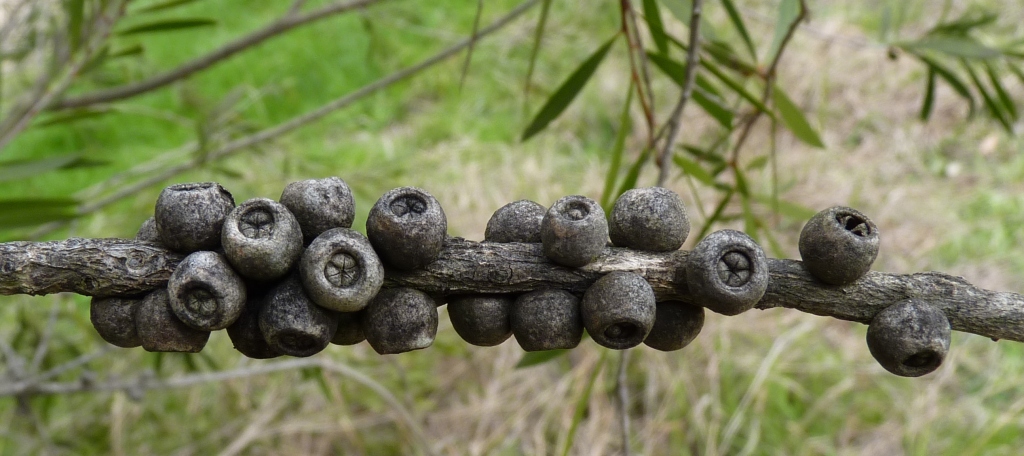Callistemon
Shrubs or small trees; bark rough, dark and fissured to pale, smooth, peeling and papery; new growth villous, often suffused with pink. Leaves alternate, sessile to shortly petiolate, terete to lanceolate or oblanceolate, entire, sometimes prominently gland-dotted, apex acute, sometimes pungent. Inflorescence spike-like, oblong to cylindric; terminal at first then axis growing from a scaly bud at the tip into a leafy shoot. Flowers 5-merous, 1 per bract, bisexual; bracts mostly brown, scarious (sometimes leaf-like), soon shed, generally with 2 minute bracteoles, hypanthium urceolate to campanulate; sepals 5, more or less round, deciduous; petals 5, more or less round, exceeding the sepals, deciduous; stamens numerous, at least twice as long as petals, free or rarely shortly united at the base, white to yellow, green, pink, lilac or crimson, anthers versatile, yellow or dark purplish-black; ovary 3(–4)-celled, half-inferior; style with capitate stigma. Fruit a woody loculicidal capsule, 3(–4) valved, often persistent on the stem and enlarging for many years; seeds angular, numerous.
About 30 species endemic to Australia and present in all States (New Caledonia has 5 anomalous species that are sometimes placed in either Callistemon or Melaleuca).
Callistemon is sometimes included in Melaleuca. DNA studies have shown Melaleuca to be polyphyletic, with Callistemon nested within it. However, at this stage no morphological characters have been established to uniquely define clades (i.e. genera) within the broad Melaleuceae tribe, nor are there morphological characters that define this group if it were to be treated as a single genus (i.e. subsume all taxa into Melaleuca as currently proposed by some authors). As such, Melaleuca and Callistemon are retained here as separate genera until the taxonomy of this group is fully resolved.
Fruit dimensions are of mature capsules, 1–2 years post-flowering.
Spencer, R.D. (1996). Callistemon. In: Walsh, N.G.; Entwisle, T.J., Flora of Victoria Vol. 3, Dicotyledons Winteraceae to Myrtaceae, pp. 1022–1027. Inkata Press, Melbourne.
 Spinning
SpinningBrown, G.K.; Udovicic, F.; Ladiges, P.Y. (2001). Molecular phylogeny and biogeography of Melaleuca, Callistemon and related genera (Myrtaceae). Australian 14: 565–585.
Craven, L.A. (2006). New combinations in Melaleuca for Australian Species of Callistemon (Myrtaceae). Novon 16: 468–475.
Edwards, R.D.; Craven, L.A.; Crisp, M.D.; Cook, L.G. (2010). Melaleuca revisited: cpDNA and morphological data confirm that Melaleuca L. (Myrtaceae) is not monophyletic. Taxon 59: 744–754.
Ladiges, P.Y.; McFadden, G.I.; Middleton, N.; Orlovich, D.A.; Treloar, N.; Udovicic, F. (1999). Phylogeny of Melaleuca, Callistemon, and related genera of the Beaufortia suballiance (Myrtaceae) based on 5S and ITS-1 spacer regions of nrDNA. Cladistics 15: 151–172.
Udovicic, F.; Spencer, R.D. (2012). New combinations in Callistemon (Myrtaceae). Muelleria 30: 23–25.


